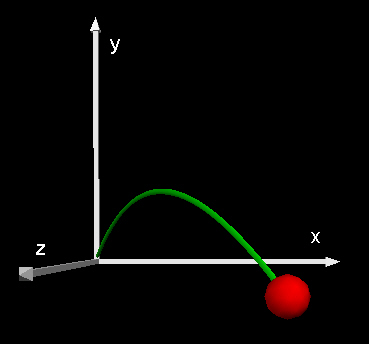Motion in 2 and 3 Dimensions
an introduction to VPython and Assorted JAVA Applets
The following is intended to be a self-paced"tutorial" introducing
the following ideas:
- independence of motion

- algebraic representations of vectors
- using vector notation
- programming in VPython - a simple OOP environment
- kinematic equations in 2 and 3 D cases
- modeling of the physical world
What to Do
Answer the following as appropriate:
Use accel2D
to explain:
- how to create a parabolic path
- how to create a circular path
- what happens if the acceleration vector is not perpendicular or parallel
to the velocity vector
- Generate a parabolic path and show that the x-t, vx-t and y-t, vy-t and
ay-t graphs are the ones you would expect to get based on what you know about
kinematics.
- Explain what happens if you accelerate in some direction that is not parallel
or perpendicular to the initial velocity. How can you determine speed and
displacement now?
Using VPython
Download the file 3dtraj.py and use it as
the starting point for your investigation. Spend some time looking at how the
code is put together and then experiment with it. YOU CAN'T BREAK ANYTHING (well,
maybe Nathan, BUT)....
Suppose a ball is thrown with an initial velocity given by the vector v(15,25,20)
- How fast is it going?
- How could you describe its direction using our usual N,S,E,W conventions?
- How long will the flight last?
- What is the highest point on its path and when does it get there?
- Where does the ball land?
Special Challenge (2 mark bonus)
Air resistance is a force that is velocity dependent. The faster you move the
greater the force of resistance. Create a VPython model that can simulate the
effects that resistance would have on the motion of a body. Since the world
series is coming up, it would be interesting to try and model a curve ball or
curve/slider.
Due: September 28, 2001

